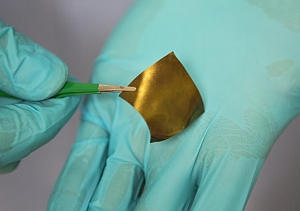Engineers and physicists at University of Michigan in Ann Arbor devised a method for transforming gold nanoparticles into conductive chains that stretch to nearly six times their original length and still conduct a current. The team led by Michigan chemical engineering professor Nicholas Kotov, with participants from the Korea Basic Science Institute in Daejeon, published their findings online yesterday in the journal Nature (paid subscription required).
The university says it plans to file a patent for the discovery and is seeking business partners to bring the technology to market.
In the study, Kotov and colleagues looked for a practical method to make stretchable conductive materials for bendable displays, batteries, and electronic human implants. A key issue in flexible electronics is the trade-off between stretchability and conductivity; the more a material stretches, the greater the molecular deformation in that material, and thus a greater difficulty in conducting an electric current.
Previous attempts tried solutions such as coils, liquid metals, and nanowire networks. The researchers found a different approach that provided a solution, namely embedding round gold nanoparticles in polyurethane plastic.
The researchers discovered that stretching the plastic causes the embedded nanoparticles to self-assemble into chains with the ability to conduct a current, by leaking through gaps in the polyurethane as it stretched. When the plastic is relaxed, the nanoparticles then revert back to their more random state.
The team tested two configurations of the embedded nanoparticles and monitored each version of the material with electron microscope images. One method stacked alternating layers of plastic and nanoparticles, with five layers of gold encased in the plastic. The second method filtered a liquid with the gold nanoparticles suspended in polyurethane, leaving behind a concentrate that was also configured into layers.
Kotov and associates found the stacked-layer approach had greater conductivity. Without stretching, the stacked layers had a conductive ability similar to mercury. When stretched to twice its original size, almost to its breaking point, it still conducts a current exceeding that of today’s plastic conductors.
In the filtered configuration, the embedded gold nanoparticles have less conductivity, but much more stretchability. The researchers found they can stretch the material to 5.8 times its original size and it still conducts a weak current.
Kotov believes a key potential application of the discovery is in electrodes for brain implants to treat neuro-degenerative diseases like Alzheimer’s disease and Parkinson’s disease, as well as brain-controlled prosthetic devices. Rigid electrodes can create scar tissue, notes Kotov, that over time impairs the electrode, but more flexible electrodes that move with brain tissue could avoid that damage.
Kotov and first author Yoonseob Kim tell more about their research in the following video.
- 3-D Conductive Structures Built with Liquid Metal
- Electronic Skin Material Devised to Detect Multiple Senses
- Lighter, Stronger Metallic Bubble Wrap Developed
- Inkjet Print Process Devised for Quantum Dot Organic
- Inkjet Printing Process Devised for Graphene Circuits
* * *


 RSS - Posts
RSS - Posts
You must be logged in to post a comment.